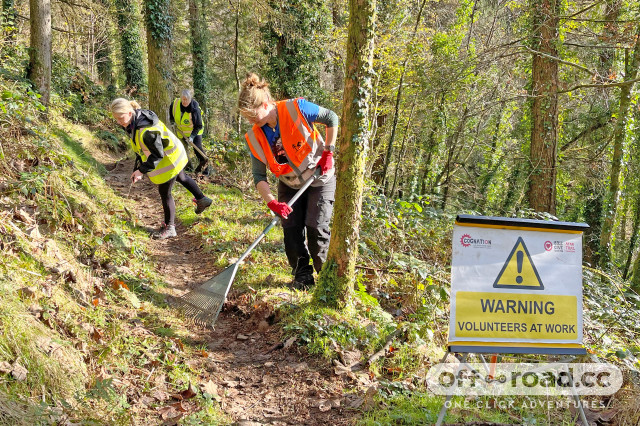What is singletrack?

Singletrack is the soul of mountain biking. Whether the singletrack you ride is a legacy riding trail, centuries-old (quite prevalent in the Alps and Pyrenees) or purpose-shaped by modern trail builders, the principle remains the same: singletrack is narrow and rewarding to ride - often resulting in an adrenaline rush and heightened sense of speed. Singletrack is the defining feature of the sport and all disciplines - downhill, enduro and cross-country mountain biking included - incorporate it into the respective formats. Here’s everything you need to know.
Trails vs singletrack - what is the difference?
There often needs to be more understanding between trails and singletracks. The former is a broader term that describes many mountain biking routes. If you think of a UCI MTB World Cup downhill mountain biking track or enduro mountain biking stage, it will often have rock gardens or large jumps in sections 20-30 feet wide, providing ample run-off area and space for riders who wish to go for the B-line.
Singletrack isn’t like that. It’s narrow. Usually 1-3 feet in width. A helpful rule is that if riders can’t pass each other, or ride abreast, they are on real ‘singletrack’.
But where do you find singletrack, who builds it, and why is it such a foundational feature of mountain biking? In the beginning, mountain bikers rode on fire service and parks board patrol roads in Northern California. These roads were wide enough to accommodate large private automobiles and the riding format in those early years of mountain biking was group rides, with mountain bikers in a loose formation, riding next to each other.
Mountain bikers soon discovered that if they ventured off the forestry service fire roads, there were terrific link trails, used mainly by hikers. These trails were much narrower and closer to the singletrack concept.
Singletrack and the sensation of speed
The incentive for singletrack riding is a sense of splendid isolation and speed. On singletrack, your sense of speed is amplified by the proximity of trees passing by. Experienced mountain bikers are familiar with this proximity effect.
You can check your Strava data and contrast it with the visceral experience of riding two singletrack trails: one in a forest and the other in open terrain. Even if you are faster in descending speed on the open trail, your sensation of speed will be greater in the forest because of that tree-blurring sensation.
Beyond the sense of speed that singletrack forest trails generate, there is the isolation value, too. That phrase might sound strange but think about it carefully. Vehicles can easily access wilderness areas if there are fire roads for them to drive on - but, on a singletrack trail, the traffic is all hikers or mountain bikers.
Environmental regulations won’t allow you to build wider fire road trails into most wilderness areas but you can apply, with moderate success, to cut singletrack. The narrowness and lower environmental degradation caused by singletrack construction mean trail builders can successfully lobby for build projects in areas that would be off-limits to wider mountain bike trails.
Natural vs man-made singletrack
It is important to remember that for all the mindfulness and healthy escapism offered by mountain biking, it is an activity that disturbs nature. And the sustainability skill is to create a trail network that rewards riders at the lowest environmental sacrifice. This is where the craft of singletrack building, or shaping, delivers value.
What are natural singletrack trails? Those would mostly be ancient walking and trading trails. These trails can often make for useful link sections on a comprehensive singletrack build project.
Building virgin singletrack isn’t the work of a moment. Skilled singletrack builders will spend hours evaluating terrain, topography, soil type and perhaps most importantly: drainage. It is ruinous and disappointing to create a singletrack trail, which requires many build days, only to have it rutted and damaged after a season. Often beyond feasible repair.
The best builders can see lines riders will want to ride in a forest or on open sloping ground. They know how to route a singletrack descent around natural terrain features (such as rocks, roots and trees), to create an immersive and rewarding riding experience. The most intuitive singletrack builders have an uncanny understanding of where to build corners that drain well after rain, without risking descending into a rutted mess during winter.
Singletrack riding rules
There is also an aspect of rider responsibility for all the privileges afforded by singletrack riding and a certain level of trail etiquette expected. How can you help keep singletrack healthy for all? Don’t drag brakes into and around switchback corners.
Shaping, padding and perfecting switchback corners are some of the most labour-intensive build features on any singletrack trail. And if you are skidding through the braking zone and into the turn-in point of a switchback, you’re just destroying the trail surface. And triggering the start of new ruts.
With many of the best singletrack trails routing pristine wilderness areas, it is crucial to avoid ‘cutting’ or going off-piste. Don’t make shortcuts between closely grouped singletrack corners in open terrain. It’s rudely indifferent rider behaviour and shows disregard for land conservation and the trail builder’s work.
Although most singletrack trails are unidirectional (ascending or descending), some are bidirectional. In this case, yield to the ascending riders. It is much easier for a descending rider on narrow, technical, singletrack to start moving again with momentum than for a rider climbing to pedalling again, once they’ve stopped.
Riding singletrack trails
There are many singletrack trails. Nearly every established local riding community and trail network has purpose-built singletrack sections.
Off-road riders should avoid the temptation to poach hiking or walking trails for riding. Unless there is signage indicating that a specific singletrack trail is for mountain biking or multiuse, steer clear of it.
Be aware of the trail colour codes, too. Singletrack trails are narrow, by definition, and leave little margin for error, when they are steep and technical. Some advanced singletrack trails can have large jumps, drop-offs and a lot of edge-riding exposure. Heed the colour grades, when riding. Green is easy, blue means moderate, red is intermediate and all black or double-black singletrack trails, are for expert riders.













